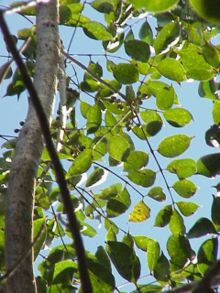Bursera
| Bursera | |
|---|---|

| |
| Bursera simaruba | |
| Scientific classification | |
| Kingdom: | Plantae |
| Clade: | Tracheophytes |
| Clade: | Angiosperms |
| Clade: | Eudicots |
| Clade: | Rosids |
| Order: | Sapindales |
| Family: | Burseraceae |
| Genus: | Bursera Jacq. ex L.[1] |
| Type species | |
| Bursera simaruba | |
| Species | |
|
About 100, see text. | |
| Synonyms | |
|
Elaphrium Jacq. | |
Bursera is a genus with about 100 described species[2] of flowering shrubs and trees varying in size up to 25 m (82 ft) high. It is the type genus for Burseraceae. The trees are native (often for many species endemic) to the Americas, from the southern United States south through to northern Argentina, in tropical and warm temperate forest habitats. It is named after the 17th-century Danish botanist Joachim Burser.
Several Mexican species (such as .
A number of species from tropical Asia were once included in this genus, but are now treated in the genus Protium.
The Bursera graveolens tree (also known as Palo Santo) belongs to this genus.
Species
Formerly placed here
- Canarium paniculatum (Lam.) Benth. ex Engl. (as B. paniculata Lam.)
- Protium serratum (Wall. ex Colebr.) Engl. (as B. serrata Wall. ex Colebr.)[5]
Uses
- Caranna, medicinal gum
Gallery
-
Bursera penicillata trunks
-
Bursera penicillata fruits and leaves
-
Bursera penicillata trunk
References
Wikimedia Commons has media related to Bursera.
Wikispecies has information related to Bursera.
- ^ "Genus: Bursera Jacq. ex L." Germplasm Resources Information Network. United States Department of Agriculture. 2007-10-05. Archived from the original on 2009-05-07. Retrieved 2010-11-18.
- ^ PMID 18927613.
no
- ^ "linaloe". Merriam-Webster.com Dictionary.
- .
- ^ a b "GRIN Species Records of Bursera". Germplasm Resources Information Network. United States Department of Agriculture. Archived from the original on 2009-01-20. Retrieved 2010-11-18.



